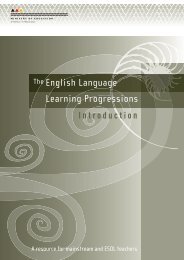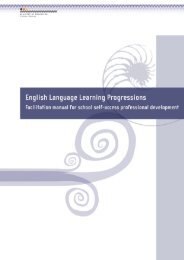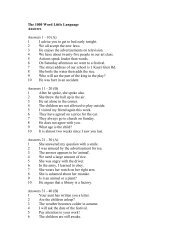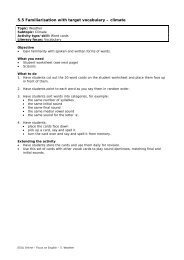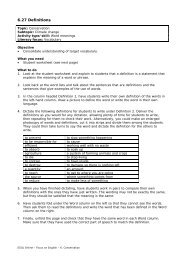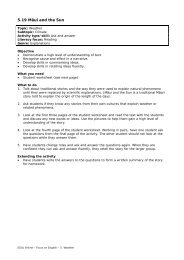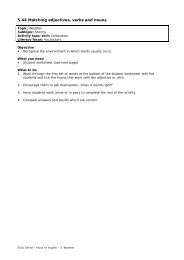ELLP Years1-4 - ESOL - Literacy Online - Te Kete Ipurangi
ELLP Years1-4 - ESOL - Literacy Online - Te Kete Ipurangi
ELLP Years1-4 - ESOL - Literacy Online - Te Kete Ipurangi
You also want an ePaper? Increase the reach of your titles
YUMPU automatically turns print PDFs into web optimized ePapers that Google loves.
Judgments about what<br />
stage a learner is at can<br />
never be “absolutely<br />
accurate”; they can only<br />
indicate the “best fit” for<br />
that learner.<br />
Best fit<br />
Assigning a text to a stage is complex and requires careful judgment and a “best fit”<br />
approach, based on a range of criteria. A learner’s written text may have some features<br />
that seem to fit into a lower stage and some that seem to fit into a higher stage.<br />
The decisions that a teacher makes about where a learner’s text fits are generalisations,<br />
but they should always be informed by the teacher’s knowledge about language. <strong>Te</strong>achers<br />
need to make their judgments on the basis of an analysis of the text at whole-text,<br />
sentence, and word levels, taking into account both deeper and surface features.<br />
Information about supporting writing development can be found in Effective <strong>Literacy</strong><br />
Practice in Years 1 to 4, Supporting English Language Learning in Primary Schools<br />
(forthcoming), The New Zealand Curriculum Exemplars: English (Written Language),<br />
asTTle: Assessment Tools for <strong>Te</strong>aching and Learning, 5 and <strong>ESOL</strong> <strong>Online</strong>.<br />
There are many different ways of describing progress in writing. The following very<br />
broad matrix is generalised to all types of text. It gives an overview of important aspects<br />
of English language learners’ writing progress rather than identifying every aspect in<br />
detail. <strong>Te</strong>achers also need to be aware that a learner’s writing will always be affected by<br />
the context of the writing task and by the prior knowledge and skills the learner brings<br />
to it.<br />
Specific indicators for different text types can be identified, for example, in the asTTle<br />
Writing Progress Indicators.<br />
This matrix focuses mainly on how writers within each broad stage of development<br />
typically organise and develop a text. It indicates the ways that a learner’s writing<br />
develops, as they move through the Foundation Stage, Stage 1, and Stage 2, in terms of<br />
their use of structures (at whole-text, paragraph, sentence, and phrase levels) and word<br />
forms in their texts. Appropriateness (in terms of purpose and audience) of content,<br />
vocabulary, and stylistic choices are also important indicators of progress.<br />
38<br />
5<br />
It is not generally suitable to use asTTle for English language learners who are in years 1–4 and are in the<br />
early stages of learning English, because asTTle levels relate to curriculum levels for native speakers<br />
of English.





